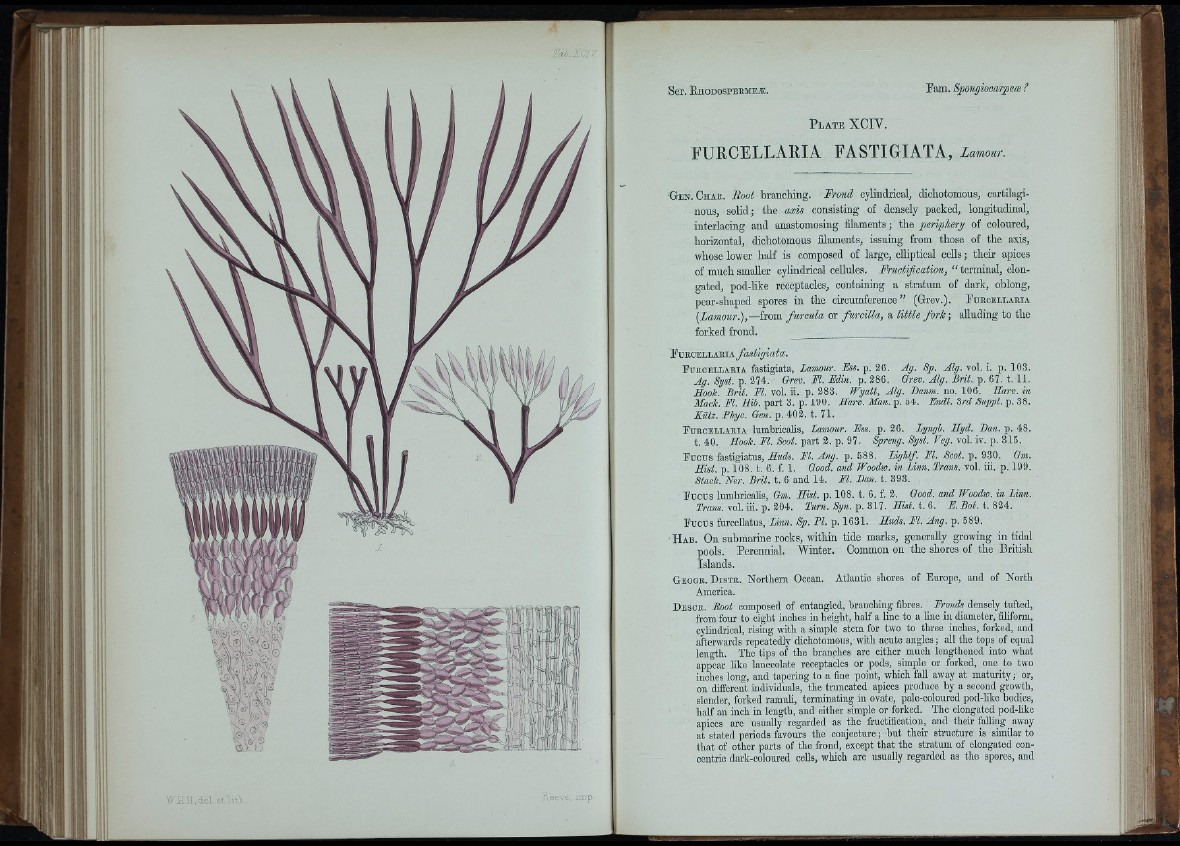
IWh. A.c.i y
P l a t e XCIV.
FURCELLAllIA FASTIGIATA, Lamour.
O e n . C h a e . Root branching. Frond cylindrical, dichotoinous, cartilaginous,
solid; the axis consisting of densely packed, longitudinal,
interlacing and anastomosing fllaments; the periphery of coloured,
horizontal, dichotomous filaments, issuing from those of the axis,
whose lower half is composed of large, eUiptical cells ; their apices
of much smaller cylindrical cellules. Fructification, “ terminal, elongated,
pod-like receptacles, containing a stratum of dark, oblong,
pear-shaped spores in the circumference” (Grev.). F ü e c e l l a e ia
{Lamour.),— irom fu r c u la ox fu r c illa , a little fo r k ; alluding to the
forked frond. ____________________
F u e c e l l a e ia fa s tig ia ta .
F u e o e l l a e ia fastigiata, Lamour. Ess. p. 36. Ag. Sp. Alg. vol. i. p. 103.
Ag. Syst. p. 374. Greo. El. Edin. p. 386. Grev. Alg. Brit. p. 67. t. 11.
Book. Brit. El. vol. ii. p. 383. Wyatt, Alg. Banm. no. 106. Harv. in
Mack. El. Hit), part 3. p. 190. Harv. Man. p. 54. Endl. 3rd Suppl. p. 38.
Kütz. EJiyc. Gen. p. 403. t. 71.
F u e c e l l a e ia lum b ric a lis , Lamour. Ess. p . 3 6 . Lyngh. Hyd. Ban. p . 4 8 .
t . 4 0 . Hook. El. Scot. p a r t 2. p . 9 7 . Spreng. Syst. Veg. vol. iv . p . 8 1 5 .
F u cu s fastigiatus, Huds. El. Ang. p. 588. LAghtf. El. Scot. p. 930. Gm.
Hist. p. 108. t. 6, f. 1. Good, and Woodw. in Linn. Trans, vol. hi. p. 199.
Stack. Ner. Brit. t. 6 and 14. El. Ban. t. 393.
F u cu s lumbricalis, Hm. Hist. p. 108. t. 6. f. 3. Good, and Woodw. in Linn.
Trans, vol. iii. p. 304. Turn. Syn. p. 317. Hist. t. 6. E. Bot. t. 834.
F u cu s furoeUatus, Linn. Sp. El. p. 1631. Huds. El. Ang. p. 589.
H a b . On submarine rocks, within tide marks, generaUy growing in tidal
pools. Perennial. Winter. Common on the shores of the British
Islands.
G e o g e . D i s t e . Northern Ocean. Atlantic shores of Europe, and of North
America.
D e s o e . Boot composed of entangled, branching fibres. Eronds densely tufted,
from four to eight inches in height, half a line to a line in diameter, filiform,
cylindrical, rising with a simple stem for two to three inches, forked, and
afterwards repeatedly dichotomous, with acute angles ; all the tops of equal
length. The tips of the branches are either much len^hened into what
appear like lanceolate receptacles or pods, simple or forked, one to two
inches long, and tapering to a fine point, which fall away at maturity ; or,
ou different individuals, the truncated apices produce by a second growth,
slender, forked ramuli, terminating in ovate, pale-coloured pod-like bodies,
half an inch in length, and either simple or forked. The elongated pod-like
apices are usually regarded as the fructification, and their felling away
at stated periods favom's the conjecture ; but their structure is similar to
that of other parts of the frond, except that the stratum of elongated concentric
dark-coloured cells, which are usuaUy regarded as the spores, and
I” M
i!
lln
|- :v;
1
/ I
i m
•I
l |
' M
W.H.K, d e l. e t li th .